
Kanishka I, or Kanishka the Great, an emperor of the Kushan dynasty in the second century, is famous for his military, political, and spiritual achievements. A descendant of Kujula Kadphises, founder of the Kushan empire, Kanishka came to rule an empire in Bactria extending to Pataliputra on the Gangetic plain. The main capital of his empire was located at Puruṣapura in Gandhara, with another major capital at Kapisa.
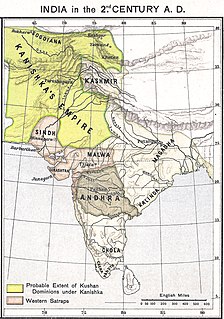
The Kushan Empire was a syncretic empire, formed by the Yuezhi, in the Bactrian territories in the early 1st century. It spread to encompass much of modern-day territory of Afghanistan, Pakistan and northern India, at least as far as Saketa and Sarnath near Varanasi (Benares), where inscriptions have been found dating to the era of the Kushan Emperor Kanishka the Great. Emperor Kanishka and the Kushans in general were great patrons of Buddhism, as well as Zoroastrianism. They played an important role in the establishment of Buddhism in the Indian subcontinent and its spread to Central Asia and China.

The Kharosthi script, also spelled Kharoshthi or Kharoṣṭhī was an ancient Indian script used in Gandhara to write Gandhari Prakrit and Sanskrit. It was used in Central Asia as well. An abugida, it was introduced at least by the middle of the 3rd century BCE, possibly during the 4th century BCE, and remained in use until it died out in its homeland around the 3rd century CE.

The Kingdom of Khotan was an ancient Iranian Saka Buddhist kingdom located on the branch of the Silk Road that ran along the southern edge of the Taklamakan Desert in the Tarim Basin. The ancient capital was originally sited to the west of modern-day Hotan at Yotkan. From the Han dynasty until at least the Tang dynasty it was known in Chinese as Yutian. This largely Buddhist kingdom existed for over a thousand years until it was conquered by the Muslim Kara-Khanid Khanate in 1006, during the Islamicisation and Turkicisation of Xinjiang.
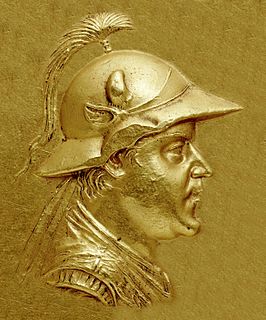
Eucratides I, sometimes called Eucratides the Great, was one of the most important Greco-Bactrian kings, descendants of dignitaries of Alexander the Great. He uprooted the Euthydemid dynasty of Greco-Bactrian kings and replaced it with his own lineage. He fought against the Indo-Greek kings, the easternmost Hellenistic rulers in northwestern India, temporarily holding territory as far as the Indus, until he was finally defeated and pushed back to Bactria. Eucratides had a vast and prestigious coinage, suggesting a rule of considerable importance.

Agathocles Dikaios was a Greco-Bactrian/Indo-Greek king, who reigned between around 190 and 180 BC. He might have been a son of Demetrius and one of his sub-kings in charge of the Paropamisade between Bactria and Indus-Ganges plains. In that case, he was a grandson of Euthydemus whom he qualified on his coins as Βασιλεὺς Θεός, Basileus Theos.
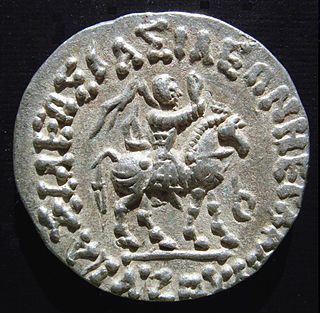
Azes II, may have been the last Indo-Scythian king in northern Indian subcontinent. His existence has been questioned — would he not have existed, artefacts attributed to his reign, such as coins, would likely be those Azes I.
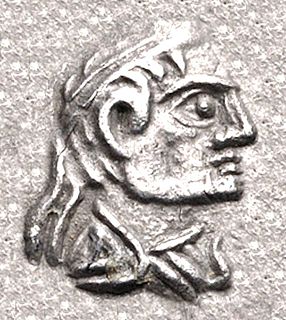
Zoilos II Soter was an Indo-Greek king who ruled in eastern Punjab. Bopearachchi dates his reign to c. 55–35 BCE, a date approximately supported by R. C. Senior. The name is often Latinized as Zoilus. It is possible that some of his coins were issued by a separate king, Zoilos III.

The Kingdom of Kuninda was an ancient central Himalayan kingdom documented from around the 2nd century BCE to the 3rd century, located in the modern state of Uttarakhand and southern areas of Himachal in northern India.

Coinage of India began anywhere between early 1st millennium BCE to the 6th century BCE, and consisted mainly of copper and silver coins in its initial stage. The coins of this period were Karshapanas or Pana. A variety of earliest Indian coins, however, unlike those circulated in West Asia, were stamped bars of metal, suggesting that the innovation of stamped currency was added to a pre-existing form of token currency which had already been present in the Janapadas and Mahajanapada kingdoms of the Early historic India. The kingdoms that minted their own coins included Gandhara, Kuntala, Kuru, Panchala, Magadha, Shakya, Surasena and Surashtra etc.
There are various kinds of Xinjiang coins produced throughout the history of Xinjiang using the styles of contemporary Chinese cash coins as well as Persian and Islamic coinages. As not many records exist from the ancient monarchies of Xinjiang the study of its coinage has determined when which rules reigned and the state of the economy based on metallurgical analyses.
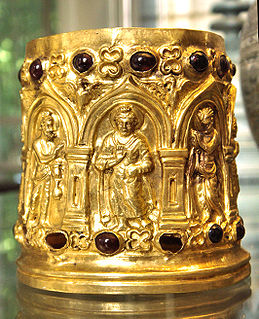
The Bimaran casket or Bimaran reliquary is a small gold reliquary for Buddhist relics that was found inside the stupa no.2 at Bimaran, near Jalalabad in eastern Afghanistan.

Sodasa was an Indo-Scythian Northern Satrap and ruler of Mathura during the later part of the 1st century BCE or the early part of 1st century CE. He was the son of Rajuvula, the Great Satrap of the region from Taxila to Mathura. He is mentioned in the Mathura lion capital.
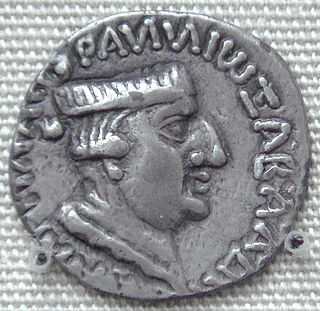
Nahapana was an important ruler of the Western Kshatrapas, descendant of the Indo-Scythians, in northwestern India. According to one of his coins, he was the son of Bhumaka.
In 1847, the Kingdom of Hawaiʻi, under the reign of King Kamehaheha III, issued its first official coinage—a large one-cent copper penny—to alleviate the chronic shortage of small denomination coins circulating in the Hawaiian Islands. The next and last official coinage of the Hawaiian Islands was minted in 1883, by King Kalākaua I; however during the intervening period, the changing needs of the Hawaiian Islands were met by circulating private-issued tokens and the coins of the United States of America.

Vashishtiputra Sātakarni was a Satavahana king, who ruled the Deccan region in India, during the 2nd century CE. He was the brother of Vasisthiputra Sri Pulamavi, his regnal successor, and the son of the great Satavahana conqueror Gautamiputra Satakarni. His reign is dated variously: 138-145 CE, or 158-165 CE.
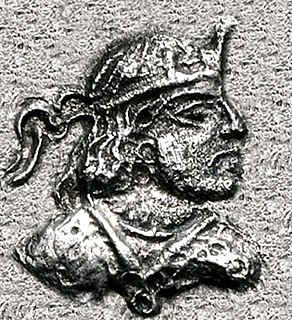
The Pāratarajas was a dynasty of Parthian kings, and ruling family from what is now Pakistan, from the 1st century to the 3rd century. The seat of their capital was Balochistan.

The Post-Mauryan coinage of Gandhara refers to the period of coinage production in Gandhara, following the breakup of the Maurya Empire. When Mauryan central power disappeared, several small independent entities were formed, which started to strike their own coins, defining a period of Post-Mauryan coinage that ends with the rise of the Gupta Empire in the 4th century CE. This phenomenon was particularly precocious and significant in the area of Gandhara in the northwest, and more particularly in the city of Taxila, in modern-day Pakistan.

The decline of the Mauryan Empire was a setback to the political unity of India. As the vast empire began to disintegrate, many small kingdoms sprained up all over the country, north and south. Taking advantage of this weakness, many tribes and powerful rules from Central Asia extended their kingdoms and began to make inroads into the North-western region. In course of time, they adopted Indian culture and became a part of the Indian population.
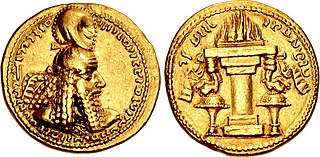
Sasanian coinage was produced within the domains of the Iranian Sasanian Empire (224–651). Together with the Roman Empire, the Sasanian Empire was the most important money-issuing polity in Late Antiquity. Sasanian coinage had a significant influence on coinage of other polities. Sasanian coins are a pivotal primary source for the study of the Sasanian period, and of major importance in history and art history in general. The Sylloge nummorum Sasanidarum is the most important primary work of reference for Sasanian coins.




















